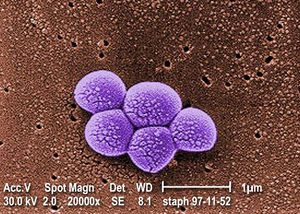Crohn’s Disease Relating to the Gut Microbiota Specifically Faecalibacterium prausnitzii
Introduction

By Kayla Arone
At right is a sample image insertion. It works for any image uploaded anywhere to MicrobeWiki.
The insertion code consists of:
Double brackets: [[
Filename: PHIL_1181_lores.jpg
Thumbnail status: |thumb|
Pixel size: |300px|
Placement on page: |right|
Legend/credit: Magnified 20,000X, this colorized scanning electron micrograph (SEM) depicts a grouping of methicillin resistant Staphylococcus aureus (MRSA) bacteria. Photo credit: CDC. Every image requires a link to the source.
Closed double brackets: ]]
Other examples:
Bold
Italic
Subscript: H2O
Superscript: Fe3+
Sample citations: [1]
[2]
A citation code consists of a hyperlinked reference within "ref" begin and end codes.
To repeat the citation for other statements, the reference needs to have a names: "<ref name=aa>"
The repeated citation works like this, with a forward slash.[1]
Background
Include some current research, with at least one figure showing data.
General Crohn's Disease Information
Intestinal Microbiota
Section 2
Include some current research, with at least one figure showing data.
Microbial Remediation of Crohn’s Disease
Include some current research, with at least one figure showing data.
Limitations and Future Research
Conclusion
Research proves the connection between the human gut microbial community and Crohn’s Disease. There is less literature on the link between, F. prausnitzii,, but enough is present to continue to research the correlation between the two on further research on the topic. Crohn’s Disease is a non-treatable illness that causes significant interference in the lives of those inflicted with it, and to move forward with trying to work to create a treatment, the factors contributing to the disease need to be understood. The effect of F. prausnitzii, on the gut-brain axis initially demonstrates the formation of this relationship with the overlap in F. prausnitzii, affecting other IBD patients. In short, the dysregulation of gut microbiota affects humans well being and Crohn’s disease is one that it causes to come to fruition. With all of this information, we can look into more possible clinical trials. Further research is needed to reach these steps, but as more is learned and developed about the connection between the gut-microbiota F. prausnitzii, and Crohn’s disease, many scientific discoveries can be created.
References
Authored for BIOL 238 Microbiology, taught by Joan Slonczewski,at Kenyon College,2024
